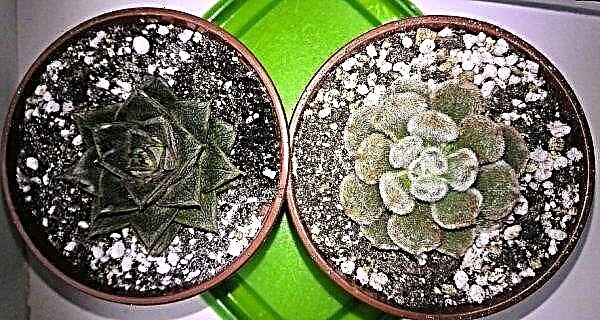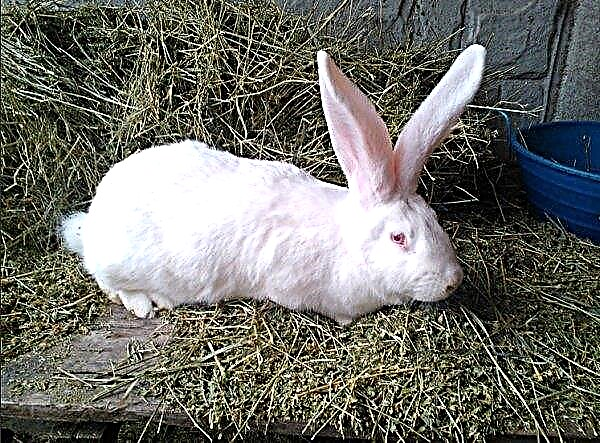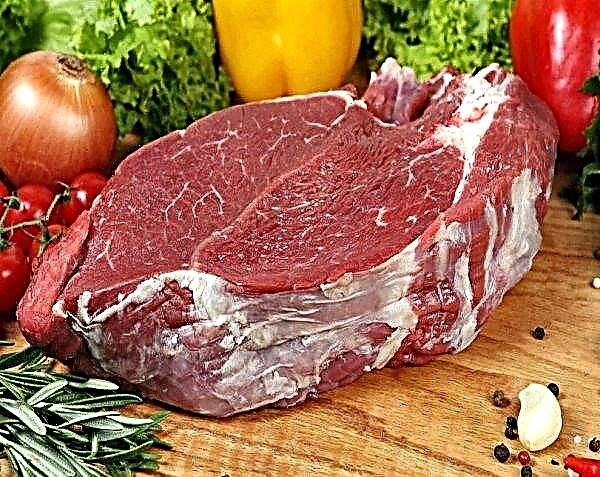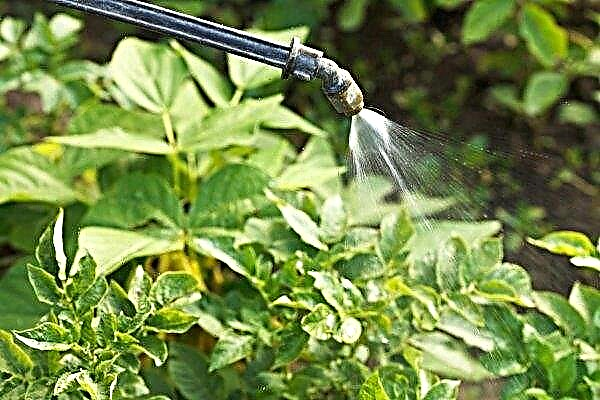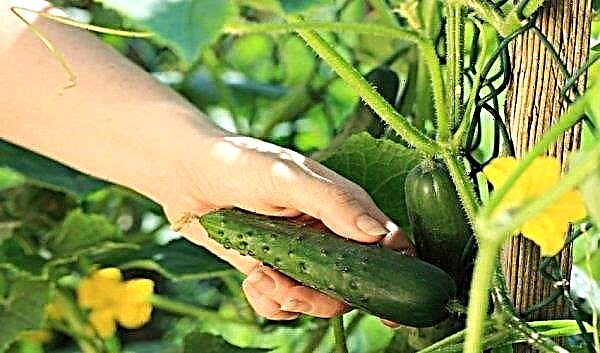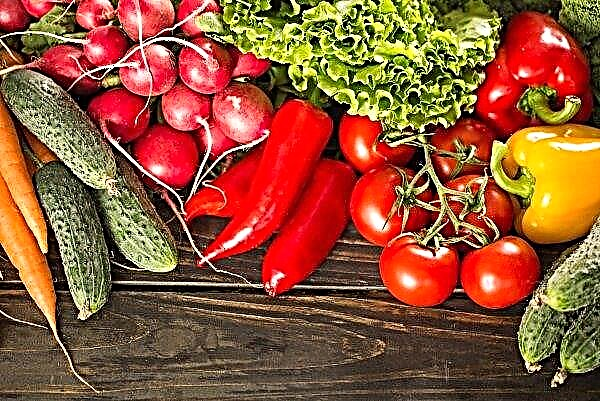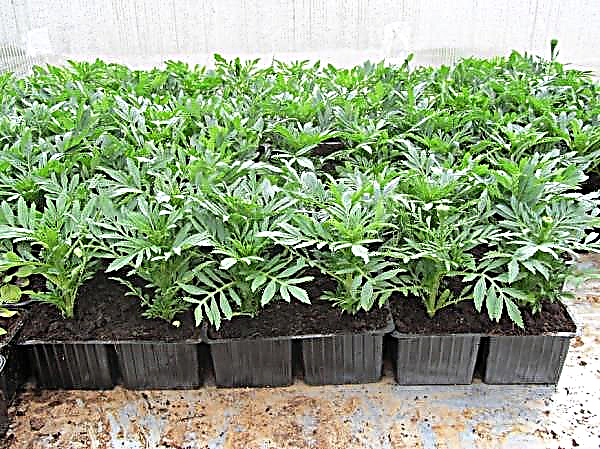In the existing variety of varieties and hybrids of sweet bell pepper, which differ in size, shape and color of the fruits, their ripening dates and other signs, it is easy to get lost. This review will help you get acquainted with an interesting version of large-fruited sweet pepper of bright red color under the self-explanatory name - Cow's ear.
Variety selection and description
The cow’s ear is a fairly young variety of pepper bred by Russian breeders on the basis of the All-Russian Research Institute of Vegetable Production (now - Agrofirm “Search”). It became available for wide use a little more than 10 years ago, after it passed the official state registration. According to its characteristics, it is suitable for cultivation on almost the entire territory of Russia, Ukraine, Belarus and other countries of the former USSR, however, in regions with a particularly severe climate, it needs a film shelter.
Did you know? The division of sweet pepper into red, yellow and green is not only decorative. It turns out that these types of vegetables have significant differences in composition: for example, green fruits contain the most substances with anti-cancer activity, red ones are very rich in vitamin C, and yellow ones are rich in potassium, phosphorus and rutin.
Botanical characteristics of the variety:
| Bush | sprawling, well-branched, fairly tall (up to 70 cm), with medium foliage |
| Leaves | medium, slightly shriveled, with a pointed tip, deep green |
| Root system | very powerful |
| Fruit arrangement | hanging (downward) |
| Fruit Sizes | 10–18 cm long, average weight 120–150 g |
| Pepper wall thickness | 0.6–0.9 cm |
| Number of Fruit Chambers | 3–4 |
| Fruit coloring | at the time of formation, green, in the stage of ripeness dark red |
| The shape and structure of the fruit | conical with a pointed tip, slightly ribbed, the skin is dense and glossy |

Advantages and disadvantages
- The advantages distinguishing the Cow's ear among other varieties of sweet pepper include, first of all:
- extensive area of zoning;
- the possibility of growing both in open ground and in greenhouses;
- fast ripening;
- high taste characteristics;
- attractive appearance (bright color, beautiful shape, pronounced gloss);
- large-fruited;
- Thickness
- good yield indicators, a large number of peppers on one plant;
- universal use (peppers can be consumed fresh, put in salads, baked, stewed, and also prepared for the winter in the form of spins, by drying or freezing);
- Suitability for transportation over long distances without loss of commercial qualities;
- good keeping performance;
- resistance to many dangerous fungal and viral diseases affecting peppers.
- Speaking about the minuses of the variety, it is usually noted that he:
- characterized by not too high germination of seeds (sometimes less than 50%);
- differs in very low resistance to cold, low temperatures are especially dangerous for a young immature plant in the spring;
- needs a lot of bright sunlight;
- Demanding on the composition of the soil and regular top dressing (otherwise, large fruit set that does not have the ability to fully ripen);
- unstable to droughts and high temperatures (an increase in air temperature above + 30 ° C during flowering or fruit laying can lead to falling flowers and ovaries, this is especially true for growing crops under film cover);
- does not tolerate moisture on the leaves, which often leads to the development of fungal infections in plants grown in greenhouses;
- because of too large fruits, it needs to be tied up a bush;
- for the same reason, it’s not good for stuffing.
How to grow seedlings at home
Theoretically, the seeds of the Cow's Ear can be sown directly on the bed, but in this case the germination is very small, and the plants that appear are lagging behind in development, get sick and rarely bring the expected yield. Therefore, traditionally growing sweet pepper begins with transplanting seedlings.
The timing
The period from mid-February to early March is usually referred to as optimal timing for planting seedlings, however, such recommendations cannot be considered absolutely correct.
Important! Under optimal conditions for growing seedlings of medium early varieties of sweet pepper, to which the Calf's ear belongs, reaches the stage of readiness for transplanting to a permanent place within 50-60 days from the moment of sowing seeds.
The moment of planting pepper seeds is determined based on two factors:
- Dates of the proposed movement of future seedlings to a permanent place (for each region it is calculated in its own way).
- The presence or absence of the opportunity to create optimal conditions for growing seedlings (primarily for temperature and lighting): the further the microclimate created for seedlings from the ideal, the longer the formation of the bush will take.
Since, depending on the specific climatic conditions and the chosen method of growing the crop (in open ground or in a greenhouse), the period of planting pepper seedlings for a permanent place can vary from early May to mid-June, it is necessary to plant seedlings in some cases already at the end of winter, in others this procedure can be safely transferred to the second half of March.
Soil and container for growing
There are two approaches to choosing the soil for growing seedlings: some prefer to use the substrate purchased in the store, others take the land in their own garden. Each of these options has its pros and cons. So, store mixes for seedlings usually undergo all the necessary enrichment and disinfection measures, but in the second case the process of plant adaptation to the new soil composition after transplantation is minimized. The two main characteristics that the soil for growing pepper seedlings must meet are looseness and lightness.
Important! Sweet pepper does not tolerate transplantation, so it is better to choose cassettes in such a way as to minimize the risk of root damage. The root system of pepper leaves vertically down in the form of a single rod, which means that the capacity should be high and have a cone-shaped narrowing in the lower part.
To ensure compliance with these requirements, for example, by mixing:
- peat and humus in equal parts;
- humus and sod land in a ratio of 2: 1 or 3: 2;
- humus, sod land, peat and sawdust in a ratio of 1: 2: 4: 1.
Before use, such a soil mixture must be decontaminated by abundantly filling the substrate with a saturated solution of potassium permanganate. In addition to the soil mixture, for the cultivation of pepper seedlings, it is necessary to choose a suitable container. Previously, boxes or boxes were used for these purposes, but today it is much more convenient to purchase special cassettes for seedlings. The advantages of such a container are obvious: they can be used repeatedly, easily installed, moved and transported, which is very convenient both for hardening seedlings and for transporting them to the site. It is even better to plant seedlings in disposable peat or cardboard cups (cassettes). These containers are made of a special biodegradable material that allows you to plant a bush in the ground along with the container in which it grows. Rotting, a glass thereby creates an additional nutrient medium for the plant. However, this kind of packaging has one significant drawback - its high cost, which is not suitable for everyone, given that every year, stocks must be completely updated.
It is even better to plant seedlings in disposable peat or cardboard cups (cassettes). These containers are made of a special biodegradable material that allows you to plant a bush in the ground along with the container in which it grows. Rotting, a glass thereby creates an additional nutrient medium for the plant. However, this kind of packaging has one significant drawback - its high cost, which is not suitable for everyone, given that every year, stocks must be completely updated.
Seed selection and preparation
The growth and fruiting of the Cow's Ear is largely dependent on the initial quality of the seeds. When purchasing planting material, you must first make sure that it is not expired. Different dates can be indicated on the packaging with seeds - collection, packaging, sale or final suitability. The suitability of the material for use can be determined only by the first or last of these dates (the moment when the product was packaged in bags or delivered for sale does not carry a fundamental information load). Sweet pepper seeds sprout for a very long time, in order to accelerate this process, they must first be sprouted.
Important! The germination of sweet pepper lasts about three years, but this period may vary depending on storage conditions, so you need to buy goods only from a trusted distributor.
However, before this, a preliminary inspection of the seeds should be carried out. To do this, the contents of the package are poured into a small container with salted water and left for 30 minutes. After a while, all the seeds that remained to float on the surface are removed. Then the sunken seeds must be moved to another container filled with a weak solution of potassium permanganate (for disinfection, you can also use aloe juice diluted with water in equal parts) and leave for another 30 minutes. Subsequently, the “pickled” seeds should be placed in a growth stimulator. This role can be played by one of the finished preparations (Kornevin, Epin, and others), organic products based on humate, nitrophos, or wood ash. The time and processing conditions depend on the chosen stimulant, for example, in sodium humate, the seeds are kept for 24 hours at a solution temperature of + 25 ... + 28 ° С. Finally, for germination, the seeds should be placed between two layers of a well-moistened soft cloth wrapped outside with cling film or plastic bag, and put in a warm place (for example, next to the battery).
This role can be played by one of the finished preparations (Kornevin, Epin, and others), organic products based on humate, nitrophos, or wood ash. The time and processing conditions depend on the chosen stimulant, for example, in sodium humate, the seeds are kept for 24 hours at a solution temperature of + 25 ... + 28 ° С. Finally, for germination, the seeds should be placed between two layers of a well-moistened soft cloth wrapped outside with cling film or plastic bag, and put in a warm place (for example, next to the battery).
The process of the appearance of the first root can drag on for 10-12 days, so from time to time you need to unfold the film and re-wet the fabric or paper. Professional preparation of seeds for sowing may also involve some additional manipulations, in particular, hardening (alternating low and high temperatures at which germinated seeds are kept) and sparging (oxygen saturation of seeds, for example, using an aquarium compressor). Each of these procedures significantly improves seed germination and increases the resistance of the future plant.
Sowing seeds
For sowing the Cow's Ear, prepared containers should be filled with about 2/3 of the soil mixture, water the soil abundantly and allow the water to completely absorb. Then, sprouted seeds are laid directly on the surface and carefully sprinkled on top with a layer of earth no more than 1-2 cm. Water should not be watered after that, otherwise the seed will go deeper than it should be, and this will greatly complicate the process of germination. As for the landing pattern, it depends on whether a subsequent dive is planned.
With pick
When sowing the Cow's Ear, it must be borne in mind that even after all the preparatory work is done, about half of the seeds still will not sprout. That is why most often sowing is carried out with a margin, that is, not one, but 2-3 seeds are placed in each cassette. At the same time, it is necessary to try to place them as far apart as possible, so that in the event of emergence of friendly shoots in one of the cells, the plants can be planted without damaging the root system of the "neighbor".
Important! The earlier picking (thinning) is carried out, the easier it is tolerated.
Seeding of seedlings at the stage of appearance of 2-3 true leaves in plants is considered optimal. Usually this moment occurs approximately 2–2.5 weeks after emergence.
Without pick
Planting seedlings without picking involves laying a single seed in each cassette. This method is good for the plant itself, since pepper, like eggplant, does not like transplants. However, given the poor germination of the Calf’s ear, the allocation of a personal cell for each seed will inevitably lead to the fact that a significant part of the cells will eventually be unfilled, which means that efforts to prepare the soil, fill the cassettes and care for seedlings during the first weeks will not get adequate recoil.
Seedling Care
After sowing seeds, the cassettes should be covered with a film or glass and put in a well-lit warm place (the ideal temperature for germination is + 23 ... + 26 ° С). Before emergence of seedlings it is not necessary to water the planted seeds, it is enough to sometimes remove the film and spray the surface of the earth with a spray gun. After the shoots appear on the surface, the film is removed, and the containers with seedlings are moved to a cooler place (air temperature +13 ... + 16 ° С in the daytime and + 8 ... + 10 ° С in the night). The more light will be provided during this period for seedlings, the faster and better it will develop.
A week later, the cassette is again placed in a warm place, where seedlings continue to grow until it is planted in open ground. Pepper should be watered as it dries. At the same time, it is better to use more water at one time than to carry out frequent and scarce watering. In addition, it is important to ensure that water does not fall on the trunk and leaves. Before transplanting seedlings into the open field, the Volovy ear can be fed 1-2 times with mineral fertilizers (5 g of urea, 30-50 g of superphosphate and 25 g of potassium sulfate per 10 l of water).
Seedling hardening
A couple of weeks before the alleged planting of seedlings in the open ground, young bushes need to be prepared for a future microclimate change. To do this, cassettes with seedlings are taken out to the balcony or left in front of an open window. It is necessary to start such a procedure on a warm and sunny day (direct rays should not burn seedlings), and limit the time of the first airing to about an hour. Gradually, the period of stay in the air increases, capturing an increasingly colder time of the day. At the moment when the boxes with seedlings stood in the open air all day, and the plants remained strong, the leaves did not droop, did not turn yellow, did not wrinkle - we can assume that the hardening was successful, and the pepper is completely ready for transplanting.
Gradually, the period of stay in the air increases, capturing an increasingly colder time of the day. At the moment when the boxes with seedlings stood in the open air all day, and the plants remained strong, the leaves did not droop, did not turn yellow, did not wrinkle - we can assume that the hardening was successful, and the pepper is completely ready for transplanting.
How to plant seedlings in a permanent place
Good and healthy seedlings are just one of the stages in growing any crop. To a lesser extent, the final result of the work is affected by how well the time and place for planting the pepper are chosen, as well as how this procedure itself is carried out.
The timing
It is, of course, very difficult to determine the exact date of disembarkation of the cow’s ear seedlings in a permanent place, however, the ideal to which you must strive must imply a combination of the following conditions:
| The age of seedlings (in days from the moment of the first emergence) | 50–60 |
| Seedling height, cm | 18–20 |
| Stem thickness, cm | 0,4–0,5 |
| Number of true leaflets | 79 |
| Vegetation phase | laying the first buds (flowering should not begin) |
| Daily average air temperature | + 15 ... + 17 ° С |
| Soil temperature at the depth of the root system (minimum 10 cm) | + 10 ... + 12 ° С |
Site selection
A sweet pepper bed is best chosen on the south side. This culture needs a lot of heat and light and does not tolerate strong winds. If groundwater runs very close to the surface of the earth, it is useful for the Cows ear to construct a high bed. This technique will protect the root system of the plant from stagnation of water and provide the aboveground part of the bush with better lighting and heating. Best of all, the Cow’s ear will feel on loam or sandstone, enriched with humus and nutrients. The culture prefers neutral acidity (pH in the range of 6–6.8).On acidic and heavy clay soils, pepper grows very poorly, therefore, if necessary, at the stage of preparing the beds, components that lower the acidity and increase friability, for example, chalk and sand, should be added to the ground. One of the secrets to success in growing any crop is the good choice of predecessors and neighbors.
The culture prefers neutral acidity (pH in the range of 6–6.8).On acidic and heavy clay soils, pepper grows very poorly, therefore, if necessary, at the stage of preparing the beds, components that lower the acidity and increase friability, for example, chalk and sand, should be added to the ground. One of the secrets to success in growing any crop is the good choice of predecessors and neighbors.
With regard to sweet pepper, you must be guided by the following rules:
| Good predecessors |
|
| Bad predecessors |
|
| Good neighbors |
|
| Bad neighbors |
|
For more than one year, it is undesirable to plant plants from the same family in one place: on the one hand, this increases the risk of damage to the culture by pathogenic microorganisms and pests that have successfully wintered in the garden, including plant debris, on the other hand, the soil is very poor, losing those are the substances that are most needed for this particular culture.
Scheme and depth of landing
The cow’s ear needs a significant amount of free space, which must be provided for each plant. Based on this, the creators recommend using a 50 × 70 cm pattern when planting this type of pepper. Having marked the future bed, you need to dig holes, the depth of which should ensure the free placement of the whole earthen coma of the seedling bush in it, while it is necessary that the root neck of the plant placed in hole, after burying it was strictly at the surface of the earth.
How to care in the open ground
Cowhide - a fairly demanding and capricious variety of sweet pepper. It is not suitable for those who are ready to get out to the summer cottage no more than once a week. However, this feature of the variety is not explained by the weak immunity of the plant, but by the large number of large fruits that it must form.
In order for this entire volume of the crop to ripen, the bush objectively needs a larger quantity compared to other varieties:
- Sveta;
- heat;
- moisture
- nutrients in the soil.

Watering
Watering the cow’s ear is necessary according to the following scheme:
- during the growing season - often, but little by little;
- during the laying and formation of fruits - less often, but very plentiful.
Did you know? Indigenous people from Latin America used bell peppers as a kind of "chemical weapon." The Indians believed that caustic smoke, which began to liberate abundantly when the seeds of the plant were placed on decaying coals, scared away not only evil spirits, but also more real enemies - wild animals and warriors from neighboring tribes.
Like other members of the nightshade family, the sweet one before does not like watering on a leaf. Water needs to be poured only in the lower part of the bush, ideally, a drip irrigation system should be provided for this purpose. In addition to the absence of risks of leaf burns and significant savings in water consumption, this method of irrigation provides preliminary heating of the water in the tape, which is very important, since watering vegetable beds is always necessary only with warm water.
Soil care
For good fruiting, the Calf's ear needs loose soil, completely free of weeds. Loosening, carried out after each watering, ensures the maximum moisture content in the ground, and weeds not only compete with peppers for nutrients and lighting, but are also “reserves” of many dangerous infections and an additional bait for pests. To solve the problem of constant cultivation and weeding, experienced gardeners use the technology of mulching the beds, covering the earth around the bush with a thick layer of organic matter - hay, straw, peat, sawdust or chopped bark.
Did you know? The story of a person’s love for sweet pepper, according to archaeologists, lasts from 6 to 9 thousand years!
Such a shelter not only retains moisture and prevents the germination of weeds, but also is an excellent organic fertilizer for next year, gradually rotting and decomposing under the influence of worms and other microorganisms that live in the soil.
Fertilizer application
Even very fertile soil, allocated for placement of beds with a cow’s ear, cannot provide a high-yielding and large-fruited variety with all the nutrients it needs. Therefore, during the season, pepper needs to be additionally fed several times. The fertilizer application scheme can be used as follows:
The fertilizer application scheme can be used as follows:
| Application Time | Structure |
| 2 weeks after transplanting seedlings in open ground |
|
| In the active phase of flowering |
|
| At the beginning of ripening |
|
If fruiting is active, and weather conditions can rely on the ripening of a new wave of fruits, the number of fertilizing during the summer can be increased.
Bushes garter
In order for the bush to withstand a large number of large fruits and not break, the cow’s ear must be tied to a support. As such, it is easiest to use an individual peg (a reinforcement bar, a metal bar, etc.), but in some cases it is better to provide for several such supports by digging them from different sides of the bush and tying the nearest trunk to each of them. The fact is that it is best to form a powerful bush of the Cow's Ear not in one, but in 2-3 stems, so the use of one common support may be inconvenient. The formation of the bush, in addition, involves the timely removal of stepsons, as well as the lowest bud and yellowed leaves. If the leaf is too strong leafy, it can be thinned out a bit to provide the fruit with sufficient lighting and ventilation.
The fact is that it is best to form a powerful bush of the Cow's Ear not in one, but in 2-3 stems, so the use of one common support may be inconvenient. The formation of the bush, in addition, involves the timely removal of stepsons, as well as the lowest bud and yellowed leaves. If the leaf is too strong leafy, it can be thinned out a bit to provide the fruit with sufficient lighting and ventilation.
The cow’s ear is a rather interesting sweet pepper variety that attracts many gardeners with high yields, as well as very large and beautiful fruits, equally suitable both for fresh consumption and for harvesting for the winter. However, when deciding to plant this variety on your site, you need to keep in mind that it requires a lot of attention and is very sensitive to adverse weather conditions and to errors in agricultural technology.


